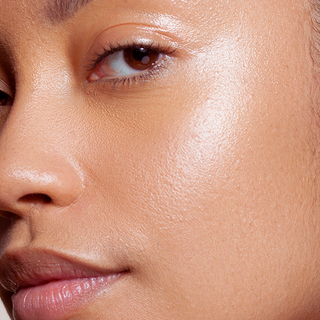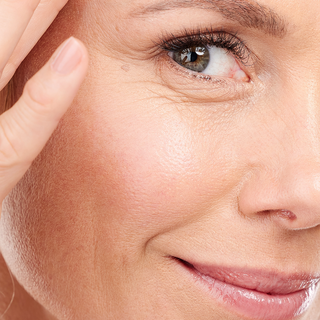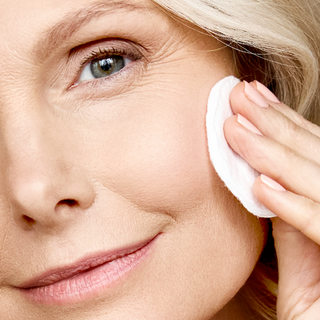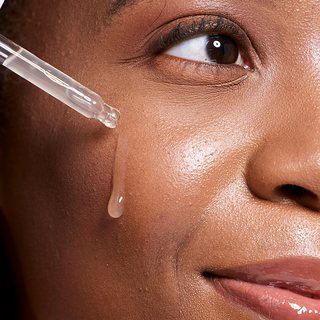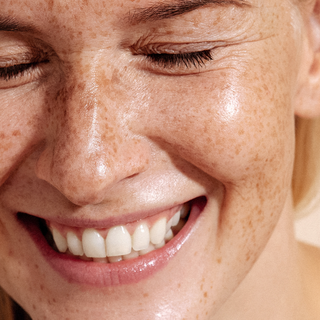Peptide serum is a skin-strengthening, collagen-boosting component that helps firm, hydrate, and smooth the skin. Think of it as your skin’s gentle yet powerful communicator, telling your cells to repair, rebuild, and glow. Here's exactly how it works, and why it’s worth your shelf space.
What Is Peptide Serum? A Beginner-Friendly Breakdown
Peptides are smart, targeted ingredients that help your skin do what it’s potentially forgotten: firm, hydrate, and regenerate, without the drama. They are amino-acid-based signals that tell your skin to get back to work, producing collagen, repairing damage, and restoring bounce.
Unlike other products that can’t penetrate deeply enough to make a difference, serums are built for performance. They sink deeper, work harder, and are designed to spark real change beneath the surface.
Let’s dive deeper into how these tiny powerhouses work, and why they’ve earned a permanent spot in simplified, effective routines.
How Do Peptides Work On Skin?
Peptides are like skilled messengers whispering instructions to your skin cells.
Here’s the kicker: your skin already produces peptides naturally. But as we age, that internal production slows down, right alongside collagen and elastin. That’s where peptide serums come in.
By applying them topically in the right delivery system, you're giving your skin a gentle nudge to get back to doing what it used to do on its own: firming up, smoothing out, and repairing damage beneath the surface.
And no, this isn’t about hype. I’ve seen peptides transform dull, tired, or fragile skin in clients who couldn’t tolerate retinol or were pregnant and needed safer alternatives.
With the right formula, peptides don’t just play a background role, they lead the entire glow up.
Peptide Serum Benefits You’ll Actually Notice
When a product makes it into my personal routine and the treatment room, it has to check a few non-negotiables: visible results, real science, and no unnecessary irritation.
Peptide serums do just that, and then some.
Let’s break down what you’ll actually see and feel when peptides become a staple in your skincare lineup.
✨ Smoother Fine Lines & Wrinkles
One of the most celebrated benefits of peptides is their ability to reduce the appearance of fine lines and wrinkles. Certain types, like enzyme-inhibitor peptides, can relax facial tension (similar to Botox, but without the needle), while others stimulate collagen to naturally plump the skin over time.
The result?
Softer crow’s feet, less creasing, and a smoother canvas, especially when used consistently.
💪 Firmer, More Elastic Skin
Peptides help rebuild the skin’s support structure by increasing both collagen and elastin production. This means more lift, more bounce, and less sagging, especially around the jawline and cheeks.
Clients often tell me their skin “feels tighter” after just a few weeks, which is exactly what we want.
💧 Deep Hydration That Lasts
Most high-quality peptide serums (like our Nourishing HA Peptide Serum) include hyaluronic acid, a hydration magnet that draws moisture into the skin. Together, peptides and HA create a dewy, well-cushioned feel that isn’t just surface-level, it’s skin repair in action.
Expect a plump, pillowy glow, especially if you’ve been feeling dry or depleted.
🧱 Stronger Skin Barrier = Less Redness
Peptides support the skin’s natural defense system, helping to rebuild a healthy barrier. This is key if you’re prone to sensitivity, redness, or post-treatment irritation.
Many of my clients who couldn’t tolerate retinoids or acids have seen amazing results using peptides to restore calm and resilience to their skin.
🎯 More Even Tone & Fewer Dark Spots
By supporting skin renewal at a cellular level, peptides can help fade discoloration, especially when paired with brighteners like niacinamide. Over time, this leads to a more uniform tone, less dullness, and skin that reflects light more evenly (a.k.a. glow).
🌿 Bonus: Fewer Breakouts
Certain peptides have antimicrobial properties, which help keep blemish-causing bacteria in check. If you’re dealing with hormonal acne or post-inflammatory flare-ups, peptides can be a surprisingly effective (and gentle) ally.
Is Peptide Serum Worth It? Real Insights Only.
Let’s be real, there are plenty of products on the market that promise youthful, glowing skin but deliver little more than a dewy finish and a dent in your wallet.
So, it’s fair to ask: Are peptide serums just fancy water with a science-y name slapped on the label?
Absolutely not, if you’re choosing the right formula.
💡 Peptides With Purpose, Not Just Hype
Numerous studies have shown the true potential and benefits of amino acid chains on the skin. That’s not marketing fluff; that’s cellular biology.
What sets the effective serums apart from the imposters is concentration and formulation. If peptides are buried at the bottom of the ingredient list, you’re likely not getting enough to see results.
Instead, look for specific peptides like Matrixyl 3000, Palmitoyl Tripeptide-1, or Argireline listed in the top half of the label.
Pro tip: Always read past the pretty packaging. The best peptide serums will name their actives and explain what they do.
🔬 Sensitive Skin? Patch Test First
Peptides are known for being gentle, but that doesn’t mean every formula plays well with your skin. Always patch test new serums on your inner arm or jawline before applying to your full face, especially if you’re reactive or dealing with conditions like eczema or rosacea.
🧴 Why Peptides Are Lazy Skincare (And That’s A Good Thing)
Here’s what I love most about peptide serums: they work behind the scenes. You don’t need to feel a tingle or wait for peeling to know they’re doing their job.
They hydrate, firm, and repair while you sleep or run errands; low effort, high reward.
How To Use Peptide Serum (The Right Way)
You don’t need a 12-step skincare routine to get glowing, healthy skin, you just need smart ingredients used in the right order.
And peptide serum? It’s one of the easiest, most rewarding steps you can add to your regimen.
Whether you're layering it between your vitamin C and moisturizer or using it as a gentle buffer between retinol nights, here's exactly how to make peptide serum work for you, not against your other actives.
🧼 Step 1: Cleanse Gently
Start with a clean canvas. Use a non-stripping cleanser suited to your skin type. If your skin tends to feel tight or reactive, go for something calming, it preps the skin without disrupting your barrier.
Try → Soothing Peptide Cleanse
💧 Step 2: (Optional) Apply A Toner Or Essence
Toners can help rebalance your skin’s pH after cleansing and improve product absorption. Go for alcohol-free, hydrating options, especially if your routine includes other actives like acids or retinol.
🧪 Step 3: Apply Your Peptide Serum
Now’s the moment. While your skin is still slightly damp, apply 1–2 pumps of peptide serum across your face and neck. Press it in gently, don’t rub. Peptides are delicate and designed to absorb slowly for maximum cellular impact.
Morning tip: Use a peptide serum that includes HA and niacinamide for a plump, dewy base.
Evening tip: If your skin is barrier-compromised from retinol or exfoliation, peptides help speed recovery overnight.
Try → Nourishing HA Peptide Serum
☀️🌙 Step 5: Spf (Am)
In the morning, your last step is always sunscreen, no exceptions. UV exposure breaks down collagen and undoes all that peptide-powered progress.
Try → Illuminating Beauty Balm SPF 44
At night, peptides play well with retinol, but only if your skin can handle it.
For beginners or sensitive types, try alternating nights (peptides one night, retinol the next) or layering peptides underneath a gentler retinoid formula. They’ll help offset irritation and strengthen your skin’s tolerance over time.
🧴 Step 5: Seal It In With Moisturizer
Always follow with a moisturizer to lock in hydration and support the skin barrier. Look for something with ceramides, HA, or peptides for a little added boost.
Try → Barrier Replenishing Cream
⏳ When Will You See Results?
Peptides don’t work overnight, but they do work. Most people begin noticing smoother texture, improved hydration, and a more refined tone within 2–4 weeks. Firmer skin and reduced lines often show up around the 6–8 week mark with consistent use.
Can I Use Peptides With Other Actives? Yes, But Read This First
If your skincare shelf is already home to things like vitamin C, snail mucin, glycolic acid, or tretinoin, you might be wondering: Do I need peptides, or will they interfere?
Let me be clear: peptides aren’t picky, but you do need to know how to pair them for maximum payoff.
🧪 Peptides + Vitamin C = Power Couple
Peptides and vitamin C work beautifully together, especially in the morning. While vitamin C neutralizes free radicals and boosts brightness, peptides step in to support collagen production and skin resilience.
Use your vitamin C first, followed by your peptide serum. The combo helps firm, brighten, and protect your skin throughout the day, especially when finished with SPF.
🌙 Peptides + Retinol = Yes (But Use Smartly)
This duo is a favorite of mine, especially for clients easing into retinoids. You can either:
-
Layer peptides under your retinol at night to help minimize dryness or irritation
-
Alternate nights, retinol one night, peptides the next, if your skin is easily overwhelmed
Peptides are especially helpful in building tolerance to stronger actives like tretinoin. They support skin recovery, calm inflammation, and reinforce your barrier so you can stick with retinol long enough to see results.
⚠️ Avoid AHAs Right Before Peptides
Here’s where it gets tricky: using glycolic acid or other AHAs immediately before peptides can lower your skin’s pH and potentially destabilize peptide structures.
If you’re exfoliating with acids (like glycolic or lactic), do it in a separate routine, or give your skin a buffer.
Use acids in the evening, and peptides the following morning or on a different night entirely. Your skin will thank you for the break.
Choosing The Right Peptide Serum For Your Skin Type
Not all peptides are created equal, and neither are our skin types. The right serum for you depends not just on your age or concerns, but on how your skin behaves day-to-day.
Whether you're dry, oily, sensitive, or somewhere in between, there’s a peptide pairing that fits. Here’s a quick guide on choosing the right peptide serum based on your skin type:
🧴 Dry Or Sensitive Skin
If your skin often feels tight, flaky, or reactive, you’ll want a formula that nourishes while it restores. Look for serums that combine peptides with:
-
Hyaluronic acid for hydration
-
Ceramides to strengthen the skin barrier
-
Niacinamide or vitamin B5 for added calm and comfort
🧼 Oily Or Acne-Prone Skin
Yes, peptides can still work beautifully for breakout-prone skin. In fact, some peptides have antimicrobial properties, making them ideal for calming redness and helping reduce the risk of clogged pores.
What to look for:
-
Peptides combined with lightweight hydrators (like HA)
-
Niacinamide to reduce oil production and inflammation
-
No comedogenic oils or pore-clogging agents
✨ Look for terms like “clarifying,” “soothing,” or “non-comedogenic” on the label.
👵 Aging Or Mature Skin
If your main concerns are loss of firmness, fine lines, or a dull, crepey texture, choose serums rich in:
-
Matrixyl 3000 or Matrixyl Synthe’6 (collagen-stimulating signal peptides)
-
Argireline, known for its Botox-like line-smoothing effects
-
Copper peptides, which promote healing and elasticity
These peptides help stimulate collagen production and improve skin texture, without the irritation that sometimes comes from strong retinoids.
Should You Add a Peptide Serum to Your Routine?
Peptides are foundational: a core part of any results-driven routine that values long-term skin health over flash-in-the-pan hype.
So, should you add a peptide serum to your routine? Absolutely, yes!
Maria Kane takes the guesswork out of skincare. That’s why our Nourishing HA Peptide Serum is packed with clinical-grade peptides, niacinamide, and multi-molecular hyaluronic acid, so you can hydrate, firm, and brighten in one clean, effective step.
Because real skincare isn’t about doing more, it’s about doing what works. And peptides? They work.


